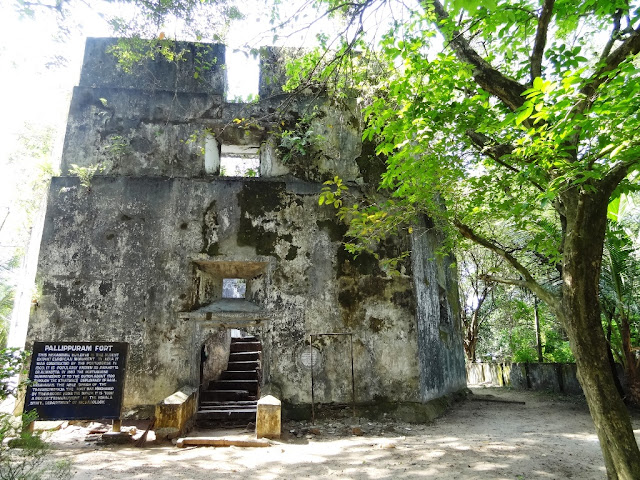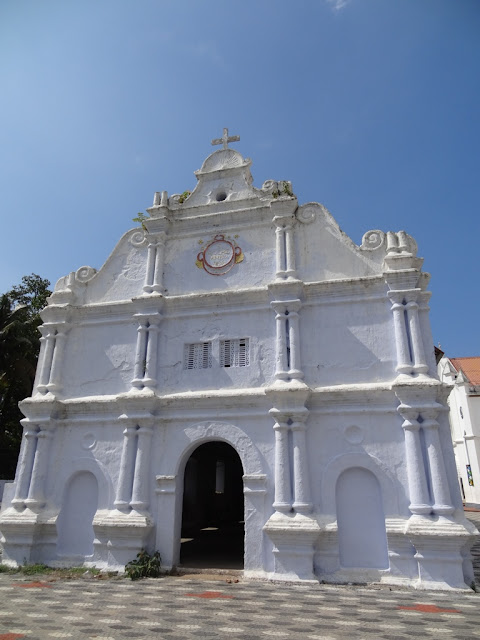After visiting the
Paravur synagogue, I started walking back to the boat Jetty, which is hardly 300 meters from the synagogue. The tickets for the Hop-on Hop-off boat service has to be obtained from the tourism office in the Paravur synagogue premises. As I walked through the narrow bylines of North Paravur, I couldn't help but wonder the enormous historical events took place at this sleepy island villages.
While walking towards the Jetty one thing strikes instantly - the street is spotlessly clean. Unfortunately in India, it is a rare sight. The crew of the Muziris heritage tour was waiting for us and soon the boat started sailing gently over the small canals flowing towards the Periyar river. The boat driver was a jovial fellow. He steered the boat and engaged us in conversations - the tidbits that only a local knows.
As we proceeded towards the next destination - The Pallippuram fort- our friendly driver showed us the special enclosures where the prawns are cultivated, the iconic "cheena valas"- a specific type of fishing nets and the boats under construction.
 |
| Cheenavala(Meaning the Chinese net) - The traditional fishing nets in Kerala |
We were striking quite a conversation about the region and in no time the boat was near the Manjumatha church jetty. A walk of half kilometer from Manjumatha church would lead us to the first ever European monument in India - The Pallippuram Fort.
As I stood before the information board at the Pallippuram Fort, I was wondering how many travelers would appreciate it's immense historical value. The fort looks quite simple and dilapidated. It has nothing to boast about visually. However once you learn about the dramatic incidents took place here during the European invasion of India, it is hard to ignore this humble fort.
 |
| Pallippuram fort - The oldest surviving European monument in India |
It is the oldest surviving European construction in India. Portuguese, soon after landing in Kerala on 1498, received the permission to build an outpost at the Northern extreme of Vypeen Island- a place named Pallipuram. This hexagonal shaped out post was built so that the entrance to the back waters from the North can be controlled. This military post is also referred to as a "fort" in the official records. The Pallippuram Fort was constructed in 1503 ( and some sources say 1507) . It was a major watch tower and was garrisoned by 20 armed men. Each of the facet of the Pallipuram fort was pierced to hold a cannon.
 |
| The information plate itself is so ancient - Made in 1909! |
However the Portuguese couldn't retain the Pallippuram for long. The Dutch under the governor Van Der Meyden conquered it with the help of Zamorins of Calicut. It was in 1661. Even though it looks like the battle between two foreign forces to establish control, in fact the bitter rivalry between the Calicut and Cochin rulers caused the seize of Pallipuram fort. Zamorins of Calicut supported the Dutch while the Cochin rulers backed Portuguese.(1)
The story of the Pallipuram fort doesn't end there. Almost more than a century later in 1789, Tippu Sultan from Mysore started a military campaign to Kerala. His aim was to conquer the Kodungallur and Pallippuram forts. The King of Travencore Wanji Bala Marthanda Rama Varma was alarmed. He
sent his first minister Kesava Pillai to strike a deal with the Dutch to purchase the Pallippuram Fort. In a transaction amounted 300,000 Surat Rupees, Dutch sold the Pallippuram and Kodungallur forts to Tranvencore(3). Tipu did attack the Pallipuram fort but was defeated and was almost killed. Hence from there on, the Pallippuram Fort remained with the rulers of Travencore, who renovated and conserved it as a historic relic in 1909.
As I stood inside that deserted fort, which was once engaged by armed men and war. I was wondering how many soldiers would fell at the same place that I stand now. How many would have died and how many would have lost their dearest dreams fighting as just pawns for the political and trade agenda of their leaders.
 |
| The Hexagonal interior of the ancient Pallippuram Fort |
We walked our way back to the Manjumatha(Our Lady of Snow) boat Jetty. We had a quick stop at the Manjumatha church compound. It was built by the Portuguese around the same time as they built the Pallippuram fort. The Portuguese dedicated this church to Our Lady. The legend says that during the invasion of Tippu Sultan in 1789, the church premises was covered in snow and Tippu couldn't proceed with his assault. After this the church was renamed to Basilica of Our Lady of Snow. In 2007, Manjumatha church celebrated it's 500th birthday. The old church has a Dutch cemetery attached to it. The ancient church is not used for adoration, it is under the archaeology department now.
 |
| The ancient church of our Lady - Pallippuram ( Manju matha church) |
It was around noon and was getting hotter. I felt very comfortable going back into the air conditioned boat. As the Muziris tour is in its beginning days, there is not much of a crowd in the boat. We started our journey towards the Kottappuram fort. As the boat gently moved over the waters of the Periyar river's tributaries, we got a glimpse of the ancient "Kanyan Thomman" church which is believed to be one of the seven(and half) churches that was founded by St. Thomas, the disciple of Jesus who arrived in India in AD 52.
 |
| Kanyan Thomman Church - one of the first churches that St.Thomas founded |
Our driver showed some queer scenes from the banks of the river, like the below boat, which had been toppled down while it was being chased by coastal police. According to our driver, that boat was trying to smuggle silver!
 |
| The Silver thief!! |
As we move through the river, we can see the workshops for boats and even big ships. After completing the construction, they would directly be pushed into the river for a test drive. However, I think the below boat was not so fortunate to touch water in it's first attempt, as it toppled down while being pushed in to the water. Poor guy!
 |
| The unfortunate first run! |
One of the amazing attractions of the Muziris Heritage tour is that, we get to see the glimpses of the daily life on river. There is no traffic jam, no honking queue of vehicles. It is just you and the boat, gently floating over the calming waters of the Periyar, owed and amused by the beauty and serenity of it's banks. The bonus is, you get to see some of the most interesting historical locations those were once part of Muziris. It is a dream come true for a lover of history and nature. (to be continued...)
 |
| A regular day at the Periyar river. |
1 Kodungallur Charithra Kazhchakal M R Raghava Warrier
2 The Dutch Power in Kerala, 1729-1758 By M O Koshy
3 TRAVANCORE STATE MANUAL By V. NAGAM AIYA










nice post.
ReplyDeleteThanks for sharing this guide with us, Do you know Vembanad is the longest lake in India, and the largest lake in the state of Kerala. It is also counted as one of the largest lakes in India. Sunset Taj Mahal Tour
ReplyDeleteAmazing PLace, Thanks for sharing these all beautiful images of this amazing place. I glad to read your article great post keep sharing. local taxi service in agra
ReplyDeleteSuch an amazing Blog you have posted. The way you expanded your travel experience is just amazing. We are quite fortunate that you provided this blog on the internet. Car Rental Delhi
ReplyDeleteSuch a helpful blog, thanks for sharing.............
ReplyDeleteTaxi Service in Jodhpur
Post a Comment